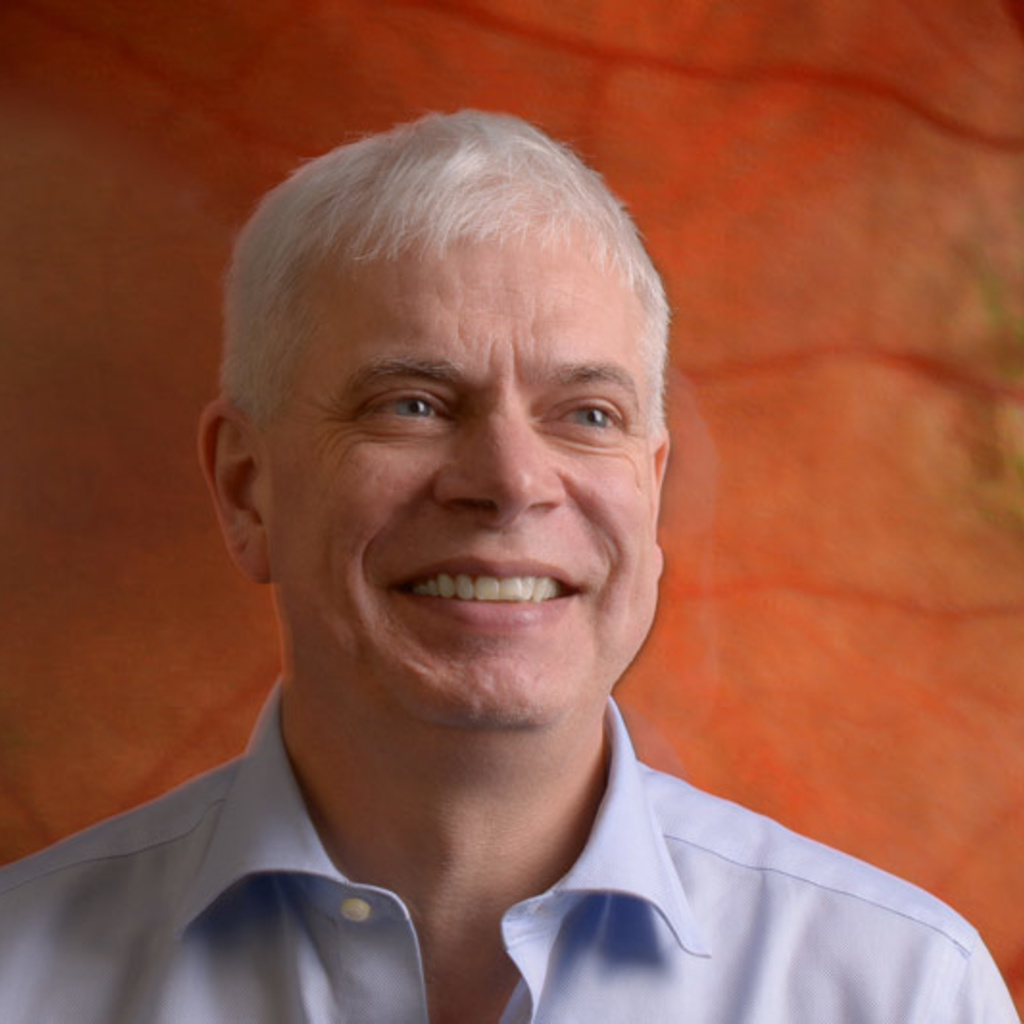
Dr. Michael Abramoff, MD, PHD
Bio:
Dr. Michael Abramoff, MD, PhD, (FARVO) is the Robert C. Watzke, MD Professor of Ophthalmology and Visual Sciences at the University of Iowa, with a joint appointment in the College of Engineering, a fellowship-trained retina specialist, computer scientist, and entrepreneur. He is an IEEE Fellow, and an ARVO Gold Fellow. In 1989-1990, he did a postdoc at the RIKEN neural networks research lab in Japan. As an expert in machine learning and image analysis, Dr. Abramoff was one of the original developers of a widely-used open-source image analysis app, ImageJ. His research has been continuously funded since 2004 by National Eye Institute, the Veterans Administration, the Beckman Foundation and other federal, state and philanthropic funding agencies in the U.S. and Europe.
Dr. Abramoff is the Founder and Executive Chairman of Digital Diagnostics, the Autonomous AI diagnostics company that was the first in any field of medicine to get FDA clearance for an autonomous AI. In primary care, the AI system can instantaneously diagnose diabetic retinopathy and diabetic macular edema at the point of care. This device, IDX-DR, is now part of ADA’s Standard Diabetes Care and Dr. Abramoff has also developed an ethical foundation for autonomous AI that was used during the design, validation, and regulatory and payment pathways for autonomous AI. As the author of over 300 peer-reviewed publications in this field, he has been cited over 35,000 times, and is the inventor on 17 issued patents and many patent applications. Dr. Abramoff has mentored dozens of engineering graduate students, ophthalmology residents, and retina fellows. His passion is to use AI to improve the affordability, accessibility and quality of care.
Description:
With the introduction of the first autonomous AI in healthcare, the eye exam for diabetes can be performed at the point-of-care with pivotal trial data that shows high accuracy and safety. The creation and acceptance of autonomous AI was facilitated by the creation of an ethical framework for healthcare AI applications. This framework was crucial in getting support for autonomous AI from all healthcare stakeholders, which has led to guidelines for regulation, reimbursement, and health considerations. Stakeholder support includes FDA review and clearance, widespread reimbursement, adoption in standards of care, and care gap closure for autonomous AI. The results of clinical trials and subsequent publications continue to show how widely implemented autonomous AI for the eye exam for diabetes is having the hoped-for effects on health, cost, and access, acting as an example for future AI applications.
2024 Lightning Talks
AI: From Nothing to Everything in 15 minutes
Presenter:
Jim Chaffee, executive director of learning innovation and technology, Tippie College of Business
Description:
Take a journey through the generative AI landscape, using AI tools to create an inviting story of higher education usage.
Implementing UI Health Care’s new intranet
Presenter:
Kelly Dreyer, intranet manager, and Crystal Hardinger, communication director, UI Health Care
Description:
UI Health Care’s previous internal communication tools were The Loop (a WordPress site) and The Point (a SharePoint on-premise site). Both platforms were at end-of-life, difficult to find relevant information, and had limited functionality and design capabilities, causing lost efficiency within the organization. After a review of needs and options, an out-of-the-box intranet platform from Interact was selected. The presentation will highlight the features and implementation process of this new platform.
Microsoft 365 Demonstration
Presenters:
Manda Marshall, senior IT support consultant, ITS Enterprise Services
Description:
This interactive presentation showcases the features and benefits of Microsoft 365 Copilot through a demonstration in which the presenter will role play a typical workday scenario. The session will also highlight how Microsoft 365 Copilot differs from Microsoft Copilot Enterprise, and how it takes using generative AI one step further than Copilot.
The Art of Prompting: Getting AI to Listen
Presenters:
Vicky Maloy, associate director of academic technologies in the ITS Office of Teaching, Learning, and Technology, Gabby Perez, compliance and education manager, ITS Research Services, Melanie Bell, technical recruiting specialist, Office of the CIO, Dave Kelly, executive director, ITS Enterprise Infrastructure, Justin Hess, senior systems administrator, UI Pharmaceuticals
Description:
Understanding how to effectively communicate with generative AI is a skill that can improve your productivity. Attendees will learn practical tips and techniques for crafting prompts that leverage AI capabilities, enabling them to use Copilot efficiently. This panel brings together professionals from various fields who have successfully integrated Microsoft Copilot into their daily lives.
- The session will begin with a brief introduction to generative AI prompts and their importance. A panel of IT professionals will then explore diverse perspectives on integrating AI into daily tasks, sharing best practices, common challenges, and innovative solutions. They will share examples of prompts and provide valuable insights into strategies to harness Copilot’s capabilities to elevate performance, foster creativity, and boost overall productivity in their respective domains. To conclude, all attendees will receive a prompting framework that can be used to develop effective prompts when engaging with generative AI.
AI Coding Assistants
Presenter:
Ross Miller, lead application developer, ITS Administrative Information Systems
Description:
In late November 2022, ChatGPT burst onto the scene, revealing the vast potential of generative AI. Today, AI coding assistants represent an instant boost in developer productivity from code suggestions, test generation and bug detection. In this talk will we explore real-world examples, comparing the ‘then’ and ‘now’ of AI integration in everyday developer work.
ASIAGO: A Collaborative Approach to Academic Accessibility
Presenter:
T.M. Weissenberger, accessibility coordinator, Information Security and Policy Office, Maggie Jesse, executive director, ITS Office of Teaching, Learning, and Technology
Description:
In the fall of 2022, a group of stakeholders from diverse work units convened to discuss academic technologies and practices that had emerged abruptly during the onset of Covid. In most cases, these discussions centered on matters of accessibility and accommodation, and ways to stabilize these tools and practices and integrate digital accessibility into a “new normal”.
In the nearly two years since that initial meeting, the UI Accessibility Support and Interest Group—now known as ASIAGO—has met with faculty, students, instructional support staff, and other members of the campus community to seek ways to better support accessibility and accommodation. ASIAGO contributors Maggie Jesse and T.M. Weissenberger will present a brief overview of this group as a model for collaboration in the accessibility space, or in any space needing distributed support.
Microsoft Copilot Studio
Presenter:
Tracy Scott, executive director, ITS Enterprise Services
Description:
Microsoft Copilot Studio is a simple, yet powerful tool for creating custom chatbots that is currently being evaluated. This session will provide a brief overview of the tool’s capabilities and share some considerations when thinking about deploying a chatbot.
Service Management Techniques You Can Use
Presenter:
Jennifer Reinier, lead application developer, Health Care Information Systems, and Dave Long, director, ITS Office of Teaching, Learning, and Technology - Instructional Services
Description:
This session will cover ITSM concepts and strategies their groups use to successfully manage change, support users, and communicate information. Take aways from this presentation include:
- Benefits of reviewing a change on Test before you make a change on Production
- Ways to keep up with the increasing rate of change from vendors
- Communication techniques to reach users where they are
- End to End Service catalog offering for an optimized customer experience
- Continued Service Improvement to improve efficiency
- An ITSM platform that supports the intake, communication, and workflow of the delivered service
- Cross-team collaboration: OneIT and Healthcare
